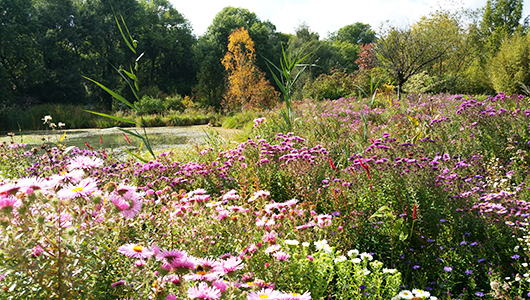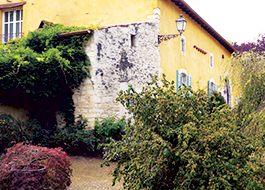Gélaucourt
Durée visite : 70 minutes
Moyen : Pédestre
La commune est récompensée depuis 2005, par la distinction Grand Prix et quatre fleurs au concours des villes et villages fleuris. Pas une façade, pas un balcon, pas un jardin ni un trottoir qui ne soient fleuris, arborés, décorés. C’est grâce à ce travail collectif, que le village a été sélectionné en 2007 pour représenter la France, au très prestigieux concours européen. Elle a eu le grand honneur de remporter le premier prix. Même le bord du petit cours d’eau qui borde le village a été aménagé. On y a créé le magnifique jardin d’eau de l’Aubepré. Cette commune, sans église, possède par ailleurs, un bel habitat du XVIIe et XVIIIe siècles. La chapelle Saint-Florentin a été détruite en 1899. Une croix marque son emplacement. Son clocher a été dressé sur le toit de la mairie.
The town has been rewarded since 2005 with the Grand Prix distinction and four flowers in the competition of towns and villages in bloom. Not a facade, not a balcony, not a garden or a sidewalk that is not flowered, wooded, decorated. It is thanks to this collective work that the village was selected in 2007 to represent France, at the very prestigious European competition. She had the great honor of winning the first prize. Even the edge of the small stream which borders the village has been developed. The magnificent Aubepré water garden was created there. This town, without a church, also has a beautiful habitat from the 17th and 18th centuries. The Saint-Florentin chapel was destroyed in 1899. A cross marks its location. Its bell tower was erected on the roof of the town hall.
Die Stadt wird seit 2005 mit der Grand-Prix-Auszeichnung und vier Blumen im Wettbewerb der blühenden Städte und Dörfer belohnt. Keine Fassade, kein Balkon, kein Garten oder Bürgersteig, der nicht geblüht, bewaldet oder dekoriert ist. Dank dieser gemeinsamen Arbeit wurde das Dorf 2007 ausgewählt, um Frankreich beim sehr prestigeträchtigen europäischen Wettbewerb zu vertreten. Sie hatte die große Ehre, den ersten Preis zu gewinnen. Sogar der Rand des kleinen Baches, der an das Dorf grenzt, wurde entwickelt. Dort wurde der prächtige Wassergarten Aubepré angelegt. Diese Stadt ohne Kirche hat auch einen schönen Lebensraum aus dem 17. und 18. Jahrhundert. Die Saint-Florentin-Kapelle wurde 1899 zerstört. Ein Kreuz markiert ihre Lage. Der Glockenturm wurde auf dem Dach des Rathauses errichtet.

D’azur à l’avant bras de carnation vêtu de gueules issant de senestre la main traversée par une flèche d’or mise en pal la pointe en bas, et en pointe une biche gisante et contournée d’argent.
Gélaucourt ou Gillocourt signifie la ferme de Gilles ; le blason illustre donc la légende de Saint Gilles. Saint Gilles vivait en ermite dans une forêt et se nourrissait du lait d’une biche qui se laissait traire par le saint. Un jour Charles Martel vint à chasser dans la forêt et les chiens suivirent la piste de la biche qui accourut se réfugier près du saint. Un veneur tira, sa flèche atteignit la main de Saint Gilles.
Azure on the forearm of carnation dressed in gules issuing from sinister the hand crossed by an arrow of gold placed in pale the point down, and in point a recumbent doe and circled Argent.
Gélaucourt or Gillocourt means Gilles farm; the coat of arms therefore illustrates the legend of Saint Gilles. Saint Gilles lived as a hermit in a forest and ate the milk of a doe which allowed itself to be milked by the saint. One day Charles Martel came to hunt in the forest and the dogs followed the trail of the doe which ran to take refuge near the saint. A huntsman fired, his arrow reached the hand of Saint Gilles.
Azurblau auf dem Unterarm der Nelke, gekleidet in Gules, die aus der finsteren Hand hervorgingen, kreuzte die Hand, die von einem Pfeil aus Gold gekreuzt war, der blass nach unten gerichtet war, und in der Spitze ein liegendes Reh und umkreiste Argent.
Gélaucourt oder Gillocourt bedeutet Gilles Farm; Das Wappen illustriert daher die Legende von Saint Gilles. Der Heilige Gilles lebte als Einsiedler in einem Wald und aß die Milch eines Rehs, das sich vom Heiligen melken ließ. Eines Tages kam Charles Martel, um im Wald zu jagen, und die Hunde folgten der Spur des Rehs, das rannte, um in der Nähe des Heiligen Zuflucht zu suchen. Ein Jäger feuerte, sein Pfeil erreichte die Hand des Heiligen Gilles.

Les habitants et les habitantes de Gélaucourt sont appelés les Gillois et les Gilloises.
The inhabitants of Gélaucourt are called the Gillois and the Gilloises.
Die Einwohner von Gélaucourt heißen Gillois und Gilloises.
Les points de visites
.
Plus de 900 variétés sont présentes. La végétation est volontairement luxuriante. En automne, elle s’embrase de mille couleurs. Label Jardin Remarquable depuis 2007, le jardin d’eau de l’Aubépré, met en scène sur un hectare, une large variété de collection d’arbres, arbustes, vivaces et essences botaniques. L’ensemble paysager est flamboyant. En toutes saisons, le jardin dévoile très généreusement ses charmes. Il diffuse ses parfums subtils : d’écorces colorées, de graminées, de grandes Berces du Caucase et bien d’autres encore. Des collections variées d’arbustes structurent et animent l’ensemble paysager. Dans le plan d’eau, les Carpes Koï jouent à cache cache avec les nymphéas. Parfums, feuillages et couleurs créent une ambiance romantique et intime. Les bancs invitent à l’évasion et au repos.
More than 900 varieties are present. The vegetation is voluntarily lush. In autumn, it is ablaze with a thousand colors. Remarkable Garden Label since 2007, the Aubépré water garden features a wide variety of trees, shrubs, perennials and botanical species over one hectare. The landscape is flamboyant. In all seasons, the garden very generously reveals its charms. It diffuses its subtle scents: colored bark, grasses, large Caucasian berries and many more. Varied collections of shrubs structure and enliven the entire landscape. In the water, the Koï Carps play hide and seek with the water lilies. Perfumes, foliage and colors create a romantic and intimate atmosphere. The benches invite you to escape and rest.
Mehr als 900 Sorten sind vorhanden. Die Vegetation ist bewusst üppig. Im Herbst brennt es mit tausend Farben. Bemerkenswertes Gartenlabel Seit 2007 bietet der Aubépré-Wassergarten auf einem Hektar eine Vielzahl von Bäumen, Sträuchern, Stauden und botanischen Arten. Die Landschaft ist extravagant. Zu jeder Jahreszeit offenbart der Garten sehr großzügig seinen Charme. Es verbreitet seine subtilen Düfte: farbige Rinde, Gräser, große kaukasische Berces und vieles mehr. Abwechslungsreiche Sammlungen von Sträuchern strukturieren und beleben die Landschaft. Im Wasser spielen die Koï-Karpfen Verstecken mit den Seerosen. Parfums, Laub und Farben schaffen eine romantische und intime Atmosphäre. Die Bänke laden zum Entkommen und Ausruhen ein.
.
.
Gélaucourt possède un beau calvaire dédié à Saint-Florentin. Il date du 16 juillet 1627, comme indiqué sur le fût. Malgré une érosion certaine, sur l’une des faces de la croix, on peut ainsi voir Saint-Florentin. Il tient un livre avec à ses pieds deux animaux, des cochons. Cela rappelle qu’il est le saint-patron du bétail domestique, et en particulier des chevaux. Sur l’autre face, on découvre le Christ sur la croix. Il est entouré par Marie-Madeleine ou Saint-Jean sans tête, d’un côté, et la Vierge les mains jointes de l’autre côté.
Gélaucourt has a beautiful Calvary dedicated to Saint-Florentin. It dates from July 16, 1627, as indicated on the barrel. In spite of a certain erosion, on one of the faces of the cross, one can thus see Saint-Florentin. He is holding a book with two animals, pigs, at his feet. It is a reminder that he is the patron saint of domestic cattle, and in particular of horses. On the other side, we discover Christ on the cross. He is surrounded by Marie-Madeleine or Saint-Jean without head, on one side, and the Virgin with folded hands on the other side.
Gélaucourt hat einen wunderschönen Kalvarienberg, der Saint-Florentin gewidmet ist. Es stammt aus dem 16. Juli 1627, wie auf dem Fass angegeben. Trotz gewisser Erosion können wir auf einer Seite des Kreuzes Saint-Florentin sehen. Er hält ein Buch mit zwei Tieren, Schweinen, zu seinen Füßen. Es ist eine Erinnerung daran, dass er der Schutzpatron der Hausrinder und insbesondere der Pferde ist. Auf der anderen Seite entdecken wir Christus am Kreuz. Er ist auf der einen Seite von Marie-Madeleine oder Saint-Jean ohne Kopf und auf der anderen Seite von der Jungfrau mit gefalteten Händen umgeben.







